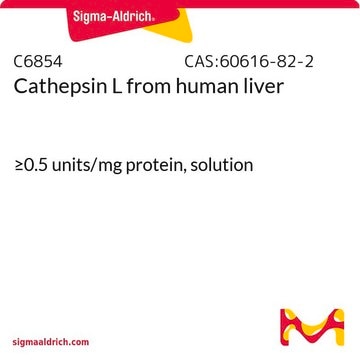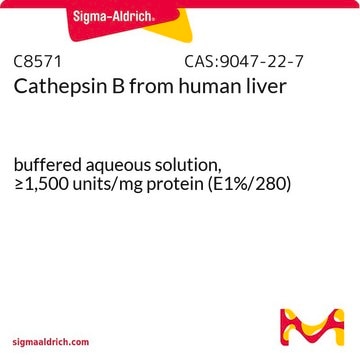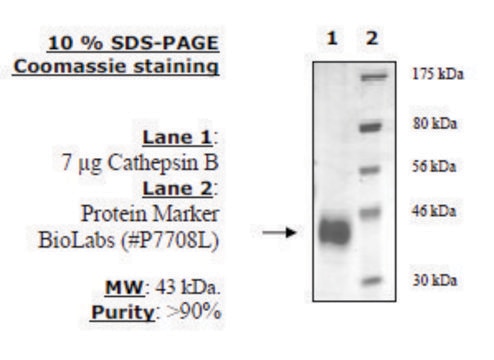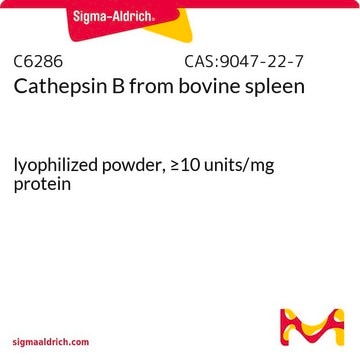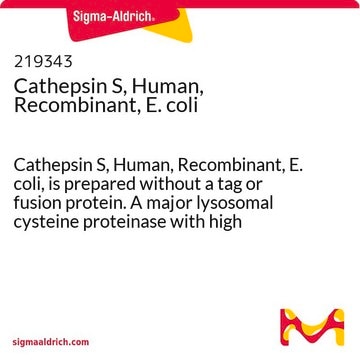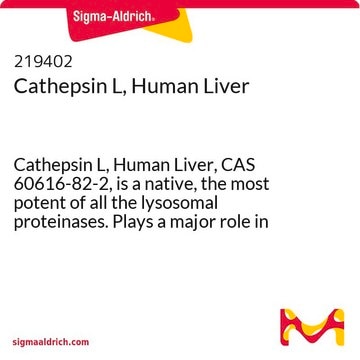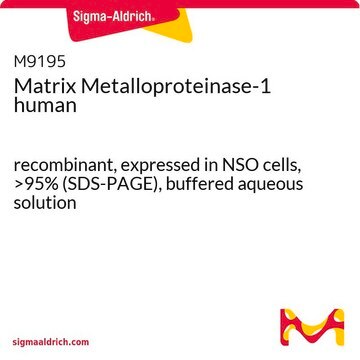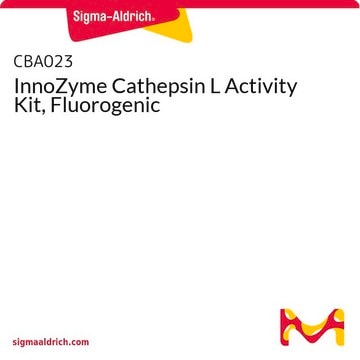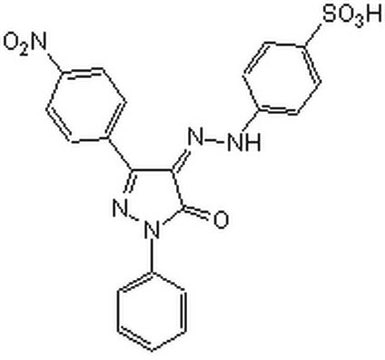SRP0291
Cathepsin L Active human
recombinant, expressed in FreeStyle™ 293-F cells, ≥90% (SDS-PAGE)
Synonym(s):
CATL, Major excreted protein (MEP)
Sign Into View Organizational & Contract Pricing
All Photos(1)
About This Item
UNSPSC Code:
12352204
NACRES:
NA.54
Recommended Products
biological source
human
recombinant
expressed in FreeStyle™ 293-F cells
assay
≥90% (SDS-PAGE)
form
aqueous solution
specific activity
≥3900 pmol/min-μg
mol wt
36 kDa
technique(s)
inhibition assay: suitable
suitability
suitable for molecular biology
NCBI accession no.
application(s)
life science and biopharma
shipped in
dry ice
storage temp.
−70°C
Gene Information
human ... CTSL(1514)
General description
Research area: Cell Signaling
Cathepsin L is a papain-like cysteine protease and belongs to the Clan A, Family C1. It is composed of L domain of α-helix and an R domain of β-sheet in the spatial structure.
Human cathepsin L (GenBank Accession No. NM_001912), amino acids 18-333, with C-terminal HIS tag, MW = 36 kDa, expressed in FreeStyle 293-F cells.
Cathepsin L is a papain-like cysteine protease and belongs to the Clan A, Family C1. It is composed of L domain of α-helix and an R domain of β-sheet in the spatial structure.
Human cathepsin L (GenBank Accession No. NM_001912), amino acids 18-333, with C-terminal HIS tag, MW = 36 kDa, expressed in FreeStyle 293-F cells.
Application
Active human cathepsin L is useful for the activation of DPP1 (Cathepsin C). Active human cathepsin L has been used:
- to determine that N-acyl and N-sulfonyloxazolidine-2,4-diones are pseudo-irreversible inhibitors of serine proteases
- to investigate the role of cathepsin B and L activity in the serum during the human aging process.
- in inhibitory activity assay
- to study the role of CTSL in COVID-19 infection
Biochem/physiol Actions
Cathepsin L is a cysteine protease, involved primarily in protein breakdown in the lysosome. Cathepsin L degrades nuclear transcription factors and may affect cell cycle regulation. Cathepsin L is also involved in the immune system, specifically in degrading the invariant chain during major histocompatibility complex (MHC) class II processing, a crucial step in antigen presentation. Its expression in the thymus has been demonstrated to be vital for the development of natural killer cells. Additionally, Cathepsin L contributes to recycling processes during axon outgrowth and synapse formation in the developing postnatal central nervous system. Proteases are associated with the development and progression of cancer. Therefore, cathepsin L may be a potential therapeutic target in cancer treatment.
Unit Definition
One unit is defined as the amount of enzyme that will cleave 1 pmol of substrate per min at 37°C
Physical form
Formulated in 50 mM MES, 400 mM NaCl, pH 5.0, and 10% glycerol.
Preparation Note
Thaw on ice. Upon first thaw, briefly spin tube containing enzyme to recover full content of the tube. Aliquot enzyme into single use aliquots. Store remaining undiluted enzyme in aliquots at -70°C. Note: Enzyme is very sensitive to freeze/thaw cycles.
Legal Information
FreeStyle is a trademark of Invitrogen Corp.
wgk_germany
WGK 1
flash_point_f
Not applicable
flash_point_c
Not applicable
Certificates of Analysis (COA)
Search for Certificates of Analysis (COA) by entering the products Lot/Batch Number. Lot and Batch Numbers can be found on a product’s label following the words ‘Lot’ or ‘Batch’.
Already Own This Product?
Find documentation for the products that you have recently purchased in the Document Library.
Ricardo A Orbegozo-Medina et al.
PloS one, 14(2), e0211035-e0211035 (2019-02-02)
Recombinant proteins expressed in E. coli are frequently purified by immobilized metal affinity chromatography (IMAC). By means of this technique, tagged proteins containing a polyhistidine sequence can be obtained up to 95% pure in a single step, but some host
Jana Ilgová et al.
Molecular and biochemical parasitology, 235, 111248-111248 (2019-12-25)
The gills of the common carp, whose mucosal surface belongs to the key defence mechanisms of piscine immunity, can be infested with both the larval and adult stage of Eudiplozoon nipponicum (Monogenea). Although on their own, monogeneans do not considerably
Elda A Treviño et al.
Journal of orthopaedic research : official publication of the Orthopaedic Research Society, 37(2), 490-502 (2018-11-21)
The etiology of joint tissue degeneration following rotator cuff tear remains unclear. Thus, the purpose of this study was to understand the timeline of protease activity in the soft tissues of the shoulder (tendon, muscle, and cartilage) that may lead
Aleksandra Wyczałkowska-Tomasik et al.
Archives of gerontology and geriatrics, 55(3), 735-738 (2012-06-15)
Cathepsin B and L are active in several physiological processes that occur in the human body. Their synthesis and activity is detectable in several tissues and processes, including skin hyperkeratosis, insemination, and embryonic development. Proteolytic enzymes are very important cellular
Ana Bela Santana et al.
Bioorganic & medicinal chemistry letters, 22(12), 3993-3997 (2012-05-19)
The synthesis, inhibitory activity and mode of action of oxazolidine-2,4-diones against porcine pancreatic elastase, here used as a model for human neutrophil elastase, are reported. The nature of N-substitution at the oxazolidine-2,4-dione scaffold has large effect on the inhibitory potency
Our team of scientists has experience in all areas of research including Life Science, Material Science, Chemical Synthesis, Chromatography, Analytical and many others.
Contact Technical Service